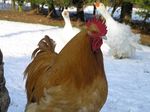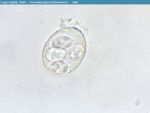Difference between revisions of "Coccidia - Poultry"
Jump to navigation
Jump to search
| Line 1: | Line 1: | ||
| − | [[Image:Buff orpington.jpg|thumb|right|150px | + | [[Image:Buff orpington.jpg|thumb|right|150px]] [[Image:Eimeria Sporulated.jpg|thumb|right|150px]] |
| − | [[Image:Eimeria Sporulated.jpg|thumb|right|150px | ||
| − | Domestic poultry and birds are affected by coccidia called Eimeria. Different species of Eimeria that effect poultry are host-specific – meaning that a species that infects chickens does not infect turkeys and vice versa. | + | Domestic poultry and birds are affected by coccidia called Eimeria. Different species of Eimeria that effect poultry are host-specific – meaning that a species that infects chickens does not infect turkeys and vice versa. |
| − | Nine species of Eimeria infect chickens. The species important in broiler production include Eimeria tenella (90%), E. maxima, E. acervulina, and E. mivati; the species important in breeder and egg- layers are E. burnetti and E. necatrix. Seven species infect turkeys – the big three of concern are Eimeria meleagrimitis, E. adenoeides, and E. gallapovonis. | + | Nine species of Eimeria infect chickens. The species important in broiler production include Eimeria tenella (90%), E. maxima, E. acervulina, and E. mivati; the species important in breeder and egg- layers are E. burnetti and E. necatrix. Seven species infect turkeys – the big three of concern are Eimeria meleagrimitis, E. adenoeides, and E. gallapovonis. |
*Direct life cycle | *Direct life cycle | ||
| Line 14: | Line 13: | ||
*2 asexual phases of multiplication called schizogony occur followed by a phase of sexual multiplication called gametogony | *2 asexual phases of multiplication called schizogony occur followed by a phase of sexual multiplication called gametogony | ||
| − | *Zygote develops into an oocyst which is then shed in the faeces | + | *Zygote develops into an oocyst which is then shed in the faeces |
**Oocyst measures 20-30μm | **Oocyst measures 20-30μm | ||
*For each oocyst ingested, thousands are shed | *For each oocyst ingested, thousands are shed | ||
| − | *Life cycle is '''self-limiting''' | + | *Life cycle is '''self-limiting''' |
| − | **Organisms from a single infection go through the sequence of developmental stages synchronously | + | **Organisms from a single infection go through the sequence of developmental stages synchronously |
**Organisms leave the body simultaneously as oocysts | **Organisms leave the body simultaneously as oocysts | ||
| − | *Oocysts are only infective once they have sporulated | + | *Oocysts are only infective once they have sporulated |
| − | **Sporulation requires warmth, moisture and oxygen | + | **Sporulation requires warmth, moisture and oxygen |
**Takes 2-3 days in broiler houses | **Takes 2-3 days in broiler houses | ||
*Oocysts contain 4 sporocysts each with 2 sporozoites | *Oocysts contain 4 sporocysts each with 2 sporozoites | ||
| − | [[Coccidiosis - Poultry]] | + | [[Coccidiosis - Poultry]] |
| − | ==Test yourself with the Coccidia Flashcards== | + | == Test yourself with the Coccidia Flashcards == |
| − | [[ | + | [[Coccidia Flashcards|Coccidia Flashcards]] |
| − | [[Category:Coccidia]][[Category: | + | [[Category:Coccidia]] [[Category:Avian Parasites]] [[Category:To_Do_-_Clinical]] [[Category:To_Do_-_Parasites]] |
| − | [[Category:To_Do_-_Clinical]][[Category: | ||
Revision as of 16:51, 24 January 2011
Domestic poultry and birds are affected by coccidia called Eimeria. Different species of Eimeria that effect poultry are host-specific – meaning that a species that infects chickens does not infect turkeys and vice versa.
Nine species of Eimeria infect chickens. The species important in broiler production include Eimeria tenella (90%), E. maxima, E. acervulina, and E. mivati; the species important in breeder and egg- layers are E. burnetti and E. necatrix. Seven species infect turkeys – the big three of concern are Eimeria meleagrimitis, E. adenoeides, and E. gallapovonis.
- Direct life cycle
- 1 week prepatent period
- After oocysts are ingested, sporozoites are released which penetrate the intestinal epithelium
- 2 asexual phases of multiplication called schizogony occur followed by a phase of sexual multiplication called gametogony
- Zygote develops into an oocyst which is then shed in the faeces
- Oocyst measures 20-30μm
- For each oocyst ingested, thousands are shed
- Life cycle is self-limiting
- Organisms from a single infection go through the sequence of developmental stages synchronously
- Organisms leave the body simultaneously as oocysts
- Oocysts are only infective once they have sporulated
- Sporulation requires warmth, moisture and oxygen
- Takes 2-3 days in broiler houses
- Oocysts contain 4 sporocysts each with 2 sporozoites

